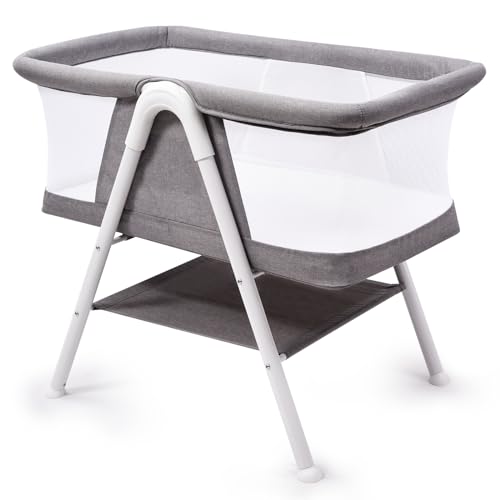The Side Sleeping Crib: A Comprehensive Guide for New Parents
Welcoming a newborn into the world is a treasured experience filled with happiness and difficulties. Amongst the many considerations new parents should browse, picking the right sleeping arrangement for their baby is paramount. One innovative service that has gained popularity over the last few years is the side sleeping crib. This post will look into the features, advantages, and factors to consider surrounding side sleeping cribs, offering an invaluable resource for new parents.
What is a Side Sleeping Crib?
A side sleeping crib, also called a co-sleeper or bedside crib, is created to offer a safe sleeping space for infants while preserving close proximity to their parents. These cribs can be attached to the side of an adult bed or utilized as standalone systems. They offer the benefit of co-sleeping without sharing the exact same sleep surface, decreasing the risk of suffocation and facilitating simpler nighttime feedings and reassuring.
Advantages of a Side Sleeping Crib
- Increased Safety
Among the primary advantages of side sleeping cribs is enhanced safety. The American Academy of Pediatrics recommends that infants sleep in the same room as their parents for at least the very first 6 months to reduce the danger of Sudden Infant Death Syndrome (SIDS). By utilizing a side sleeping crib, parents can keep their baby within arm's reach while sticking to security standards. - Convenient Nighttime Feeding
Nighttime feedings can be an exhausting regimen for new parents, however a side sleeping crib makes this procedure substantially much easier. Parents can merely reach over to comfort or breastfeed their baby without requiring to totally awake or rise. - Eases the Transition to Independence
Side sleeping cribs can help in gradually transitioning babies into independent sleep environments. Parents can move the crib further away from their bed gradually, fostering self-reliance while still maintaining a complacency for the kid. - Conserves Space
For families residing in smaller homes or houses, a side sleeping crib inhabits less space than a traditional crib, making it a perfect choice for those with limited room. - Promotes Bonding
Close proximity allows parents to easily keep track of and react to their baby's needs, fostering bonding and attachment during those vital early months.
Choosing the Right Side Sleeping Crib
When choosing a side sleeping crib, numerous aspects should be considered to guarantee it fits the requirements of both the baby and the parents:
- Safety Standards: Ensure that the crib fulfills safety requirements set by trustworthy organizations, such as the Consumer Product Safety Commission (CPSC).
- Adjustability: Look for cribs with adjustable heights to align with the parents' bed and guarantee easy access.
- Stability: A good side sleeping crib needs to be stable without wobbling or moving when connected to the parent's bed.
- Portability: Consider cribs that are light-weight and have wheels for easy motion around the house.
- Product: Opt for cribs made from non-toxic materials that are totally free from hazardous chemicals.
Aspects to Consider
While side sleeping cribs present various advantages, parents must likewise keep these elements in mind to make a notified decision:
- Size of the Bed: Ensure the crib fits firmly along with the adult bed, without gaps that could posture a safety danger.
- Baby's Growth: Be mindful that as infants grow, their sleeping requirements will alter. Some cribs are convertible and can be used longer than conventional cribs.
- Sleeping Habits: Consider how quickly you and your partner adapt to having the baby nearby during the night.
Frequently Asked Questions About Side Sleeping Cribs
Q1: Are side sleeping cribs safe for newborns?A1: Yes, side
sleeping cribs offer a safe sleeping environment for newborns when utilized correctly, as they lower the risk of SIDS while allowing parents to stay close.
Q2: How do I assemble a side sleeping crib?A2: Assembly guidelines normally accompany the crib. Ensure it is firmly connected to the adult bed, following the standards provided by the manufacturer. Q3: Can I use a side sleeping crib
for longer than six months?A3: Yes, many side sleeping cribs can accommodate infants beyond
six months, depending upon their development and advancement. Examine Portable Bedside Crib for weight and height limitations. Q4: What if my baby rolls over?A4: Most side sleeping cribs are created with security features
to prevent babies from presenting.
However, constantly monitor your baby and seek advice from pediatric standards about the correct time to transition them to a crib. The side sleeping crib is a versatile and helpful sleeping service for new parents.
It provides security, convenience, and support throughout the early phases of being a parent while promoting nearness between parent and kid. By thinking about safety requirements, adjustability, and private family needs, parents can make an educated decision about this crucial piece of baby gear. Table: Pros and Cons of Side Sleeping Cribs Pros Cons Boosted safety throughout sleep Restricted use duration as baby grows
Ease of nighttime feeding May need additional space Promotes bondingAdjustmentperiod forparents and baby Conserves physical space Possible for unpredictable sleeping patterns Aswith any parenting decision, whatworks best will constantly depend on private household dynamics. Highlighting security,comfort, and connection will help parents pickthe best sleeping arrangements for their little ones to guarantee a great start to
life.

